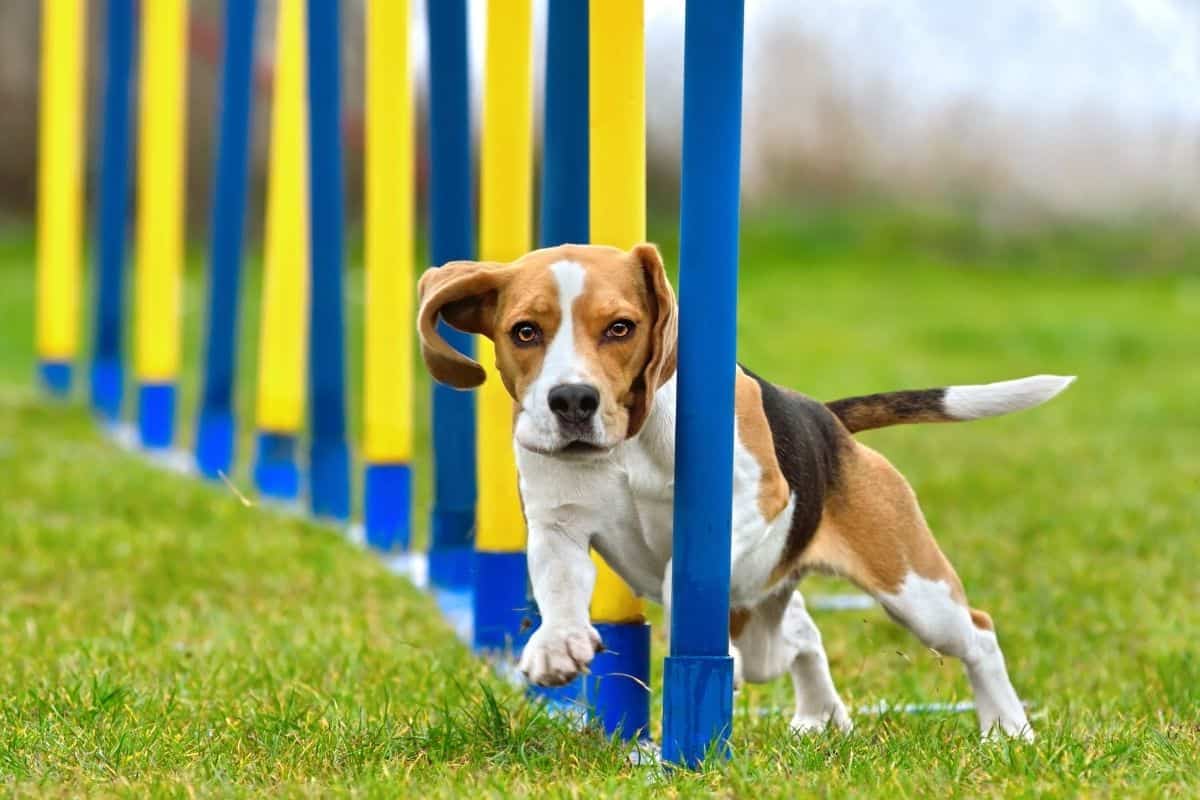Agility: A Dog Sport Guide

In the captivating world of canine sports, there's one activity that truly stands out for its combination of athleticism, teamwork, and exhilaration - dog agility! If you've ever marveled at the incredible bond between a handler and their four-legged companion, agility might just be the magic behind it.
In this comprehensive guide, we'll unravel the exciting realm of dog agility, exploring its benefits, the essential equipment, how to get started, and the key organizations that host thrilling competitions. So, get ready to embark on a journey that promises not only to keep your furry friend active and engaged but also to strengthen the remarkable bond between you and your dog.
What is Agility?
Dog agility, in essence, is a high-energy canine sport where dogs navigate through a series of obstacles on a timed course under the guidance of their handlers. These obstacles include jumps, tunnels, weave poles, and contact equipment like A-frames and teeter-totters. The true magic of agility lies in the synchrony between the dog and handler, as they work together to complete the course with precision and speed. This sport is not only a test of physical prowess but also a thrilling showcase of teamwork, communication, and trust between you and your canine companion.
In agility, dogs are challenged to dash through tunnels, leap over hurdles, weave between poles, and carefully step onto and off various contact zones. The agility course is strategically designed to assess the dog's ability to respond to their handler's cues and exhibit a high level of agility, both physically and mentally.
As dogs master agility courses, they exhibit impressive problem-solving skills and quick decision-making, improving their overall cognitive abilities. The sport encourages them to remain agile and flexible, enhancing their physical fitness, strength, and coordination. Moreover, agility tests a dog's natural instincts, making it an exciting endeavor for both the dog and its handler.
Benefits of Dog Agility
Dog agility is not just a thrilling spectacle, but it also offers a wide range of benefits for both dogs and their handlers.
- Physical Fitness: Agility training and courses demand rigorous physical activity. Dogs sprint, jump, and navigate through tunnels, which help maintain their overall fitness and build strong muscles.
- Mental Stimulation: Agility challenges dogs to think and act quickly. They must navigate the course while following the handler's cues, which keeps their minds sharp and focused.
- Improved Communication: Agility relies heavily on dog-handler communication. Handlers learn to give precise cues, and dogs learn to respond to them effectively, enhancing the overall bond between them.
- Stress Reduction: Engaging in agility activities can help alleviate stress and anxiety in dogs. It provides an outlet for excess energy and helps in relieving pent-up tension.
- Socialization: Attending agility classes and competitions exposes dogs to various people, dogs, and environments, enhancing their social skills.
- Enhanced Confidence: As dogs successfully conquer agility obstacles, they gain confidence in their abilities and feel a sense of accomplishment.
- Bonding: Participating in agility builds a unique bond between dogs and their handlers. Trust and teamwork are strengthened, leading to a more rewarding human-canine relationship.
Equipment Needed for Agility
The heart of agility training and competitions lies in the equipment that comprises a typical agility course. Here's a list of essential equipment you'll need:
- Jumps: These can be single-bar jumps, double-bar jumps, or tire jumps, each designed to challenge your dog's leaping ability.
- Tunnels: Agility tunnels come in different lengths and configurations, including straight, curved, and collapsible tunnels.
- Weave Poles: Dogs must weave through a series of upright poles to demonstrate their agility and nimbleness.
- Contact Equipment: This includes the A-frame, dog walk, teeter-totter, and the pause table. Dogs must make contact with specific parts of these obstacles to complete the course correctly.
- Tire Jump: A circular hoop suspended from a frame that tests a dog's jumping ability and accuracy.
- Agility Flooring: To ensure safety, you'll need a suitable surface for your agility activities, such as grass, rubberized mats, or even specialized agility surfaces.
- Training Accessories: Treats, toys, and clickers can be helpful tools for motivating and rewarding your dog during training.
To ensure the safety of both you and your furry friend, make sure to invest in high-quality, sturdy equipment. Remember that agility equipment varies in size and complexity, so it's essential to start with basic obstacles and gradually progress to more challenging ones as your dog gains confidence and skill.
How to Get Involved in Dog Agility
Excited to dive into the world of dog agility? Here's how you can get started:
- Find a Local Class or Trainer: The best way to begin your agility journey is to enroll in a local class or seek out a professional agility trainer. These experts will guide you and your dog through the fundamentals, ensuring you're both on the right track.
- Basic Obedience Training: Before delving into agility, it's crucial that your dog has a strong foundation in basic obedience commands. This provides the necessary groundwork for agility training.
- At-Home Practice: If attending classes regularly isn't feasible, you can still practice agility at home. Start with simple homemade obstacles like jumps and tunnels and gradually progress to more complex equipment.
- Join Agility Clubs: Many regions have agility clubs where you can meet fellow enthusiasts, attend workshops, and gain access to practice facilities. These clubs are a great resource for support and camaraderie.
- Competitions: If you're passionate about agility, you can eventually compete with your dog. Agility competitions range from local events to prestigious national and international tournaments.
Remember, the key to success in agility lies in consistent practice, patience, and positive reinforcement. It's a journey that you and your dog will embark on together, forging a unique connection as you navigate the agility courses.
Key Organizations Hosting Competitions
Agility competitions are not only thrilling but also a great way to benchmark your progress and enjoy a sense of accomplishment. Here are some key organizations that host agility competitions:
- American Kennel Club (AKC): The AKC is one of the most recognized organizations for agility competitions in the United States, offering various agility events and championships.
- United States Dog Agility Association (USDAA): USDAA organizes a wide range of agility competitions, including the popular Cynosport World Games, which welcomes competitors from around the world.
- North American Dog Agility Council (NADAC): NADAC hosts agility events that focus on fun and positive training methods, making it accessible for beginners and seasoned competitors alike.
Remember, while these organizations provide guidelines and organize competitions, agility is open to dogs of all shapes and sizes. Whether you have a small, toy breed or a large, working dog, there's a category that suits your canine companion.
Frequently Asked Questions
Agility is not limited to specific breeds. While some breeds are naturally more agile, any dog with the physical capability and the drive to participate can excel in agility. Border Collies, Australian Shepherds, and Shetland Sheepdogs are often top performers, but you'll find mixed breeds and smaller dogs thriving in the sport as well.
Agility classes or levels typically include Novice, Open, Excellent, and Master, with increasing levels of difficulty. There are also special classes for veterans and juniors, providing opportunities for dogs and handlers of all ages.
Agility can be adapted for dogs of various ages and sizes. For older dogs, lower jumps and less physically demanding courses are suitable. Smaller dogs often excel in agility, as they can easily navigate through obstacles.
Training at home is possible with basic equipment like jumps, tunnels, and weave poles. Start with simple exercises, use positive reinforcement, and gradually increase the complexity of the courses.
No prior experience is required. Beginners are encouraged to start with a qualified instructor who can teach the fundamentals of agility. Classes are structured to accommodate novices and experienced handlers alike.
The cost varies depending on factors like location, equipment quality, and training fees. Beginners can expect to spend around $150-200 for a set of basic agility equipment for the home. Competition grade equipment can range between $10,000-$15,000. Training costs vary, but group classes can range from $100 to $200 for a six-week session.
There are typically no age restrictions for handlers in agility competitions, as long as they can physically manage the course. For dogs, there is no upper age limit, and older dogs can still enjoy agility with appropriate adjustments.
Dog agility is an exhilarating journey for both dogs and their handlers, offering a myriad of physical and mental benefits while strengthening the bond between them. With the right equipment, training, and dedication, anyone can embark on this thrilling adventure. The key is to start with enthusiasm and an open heart, allowing your canine companion to lead you through the agility course with grace and agility.
So, take that first step, find a local class or club, and experience the incredible world of dog agility. Your dog will thank you for it, and the memories you create together will last a lifetime. In your pursuit of mastering dog agility, don't forget to explore the wealth of resources available through organizations like The Academy of Pet Careers, which can help you become a dog trainer. If you are considering a career in dog sports, check out the APCs program to become a dog sport trainer.
 Author - Joseph Schifano
Author - Joseph Schifano
Joseph Schifano is the owner and President of The Academy of Pet Careers. With over 20 years of experience working in the pet field, managing large scale pet care businesses, he has experience in every facet of the industry. Joseph's focus is primarily on the business of pet care but his passion is in understanding animal behavior how a dog's brain works so we can improve the care we provide as pet professionals. He is a huge advocate for Pet Empowerment and Force Free training methods. Read more in Joseph's full bio.
